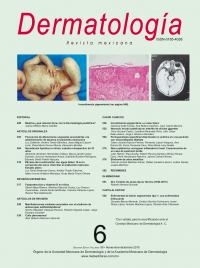Resumen
Antecedentes: la toxicidad cutánea de los taxanos, cuya acción consiste en interferir la despolimerización de los microtúbulos al fijarse sobre la β-tubulina, ocurre en 50-70% de los casos. En las uñas se ha reportado melanoniquia, onicólisis, paroniquia y hemorragia subungueal, entre otros. A pesar de que existen reportes al respecto, se desconoce la frecuencia de estas alteraciones en nuestra población.
Objetivo: determinar la frecuencia de alteraciones ungueales en pacientes que reciben quimioterapia con taxanos en comparación con los que han recibido otros agentes quimioterapéuticos.
Material y método: estudio observacional, descriptivo de casos consecutivos y seguimiento de los mismos, en el que se seleccionaron pacientes con quimioterapia con taxanos y otros agentes quimioterapéuticos; se les aplicó un cuestionario de colección de datos y se realizó exploración ungueal a los 0, 2 y 4 meses de iniciada la quimioterapia; se evaluaron las 20 uñas en búsqueda de enfermedad ungueal mediante visión directa y control iconográfico; el registro se realizó con base en el Common Terminology Criteria for Adverse Events (CTCAE v4.0). El análisis estadístico se realizó de manera descriptiva.
Resultados: se reclutaron 86 pacientes, 43 en el grupo de taxanos y 43 en el grupo control; todos los pacientes eran del género femenino, con media de edad de 50.51 ± 10.67 años. En el grupo de taxanos, 23 y 25% tuvieron cambios de coloración en las uñas al segundo y cuarto mes, respectivamente. En el grupo control, 45 y 54% tuvieron cambios de coloración en las uñas al segundo y cuarto mes, respectivamente. En el criterio de pérdida ungueal, 5 y 2.5% de los pacientes con taxanos tuvieron esta alteración en grados 1 y 2, respectivamente, en comparación con 0% del grupo sin taxanos. El 20.5 y 31% de los pacientes con taxanos padecieron surcos ungueales, contra 16 y 19% del grupo sin taxanos, a los dos y cuatro meses, respectivamente.
Conclusiones: el criterio CTCAE de pérdida ungueal se observó únicamente en pacientes en el grupo de taxanos. De la misma manera, los surcos ungueales se observaron con mayor frecuencia en las pacientes que recibían este tratamiento.
Palabras clave: toxicidad ungueal, taxanos, onicólisis, onicodistrofia, paclitaxel
Abstract
Background: The skin toxicity of taxane agents occurs in 50-70% of patients. These drugs exert their action through inhibition of the microtubules depolimerization, by binding β-tubuline. Nail toxicity has been reported as color changes, onycholysis, paronychia and subungual hematoma, among others.
Objective: To determine the frequency of nail alterations observed in patients under treatment with taxane agents and compare them with alterations found in patients receiving other chemotherapeutic agents.
Material and method: An observational, analytic, cases and control study was carried out. Patients enrolled were classified as cases when receiving taxane chemotherapy and as controls when other chemotherapeutic agents were administered. Demographic data was collected and visual inspection of the 20 nails with iconographical registration was done at 0, 2 and 4 months after the treatment was started. The registration was based on the Common Terminology Criteria for Adverse Events (CTCAE v4.0). Descriptive statistical analysis was used.
Results: Eighty-six patients were enrolled, 43 were included in the taxane group and 43 in the control group. All the patients were female; mean age was 50.51 years old. Color changes were detected in 23% and 26% of patients in the taxane group at the second and fourth months, respectively, while 45% and 54% of patients in the control group presented those changes. Nail loss was detected in 5% and 2.5% of the taxane group, classified as grade 1 and 2 respectively, compared to 0 patients in the control group. Nail ridging was found in 20.5% and 31% of patients in the taxane group, meanwhile 16% and 19% developed ridges in the control group, at the second and fourth months.
Conclusions: The CTCAE nail loss criteria was found only in patients receiving taxanes, nail ridging presented more commonly in patients belonging to the taxane group.
Keywords: nail toxicity, taxanes, onycholysis, onychodistrophy, paclitaxel

